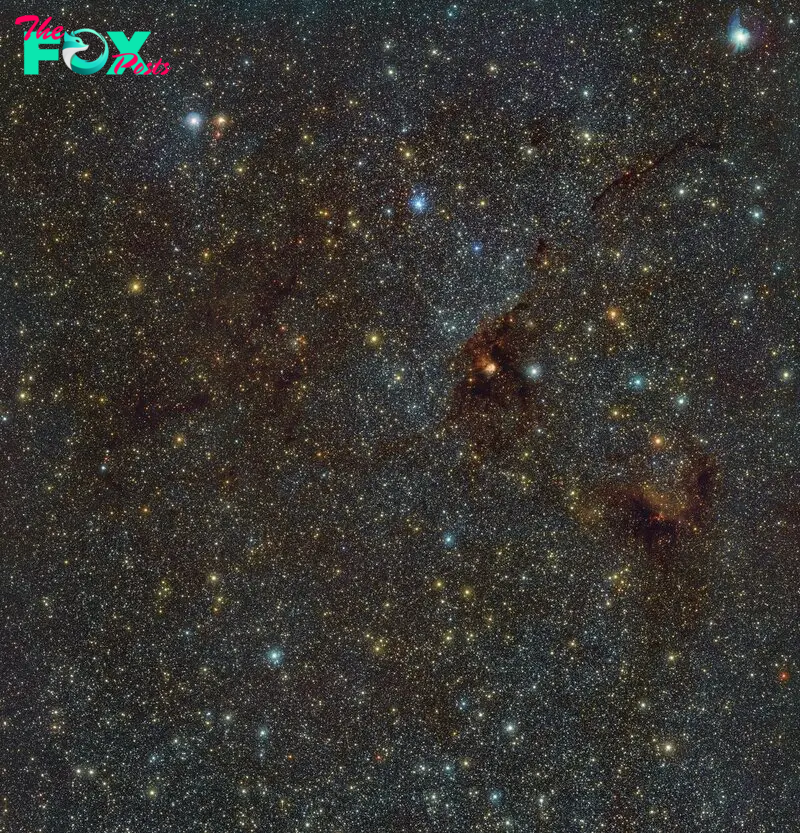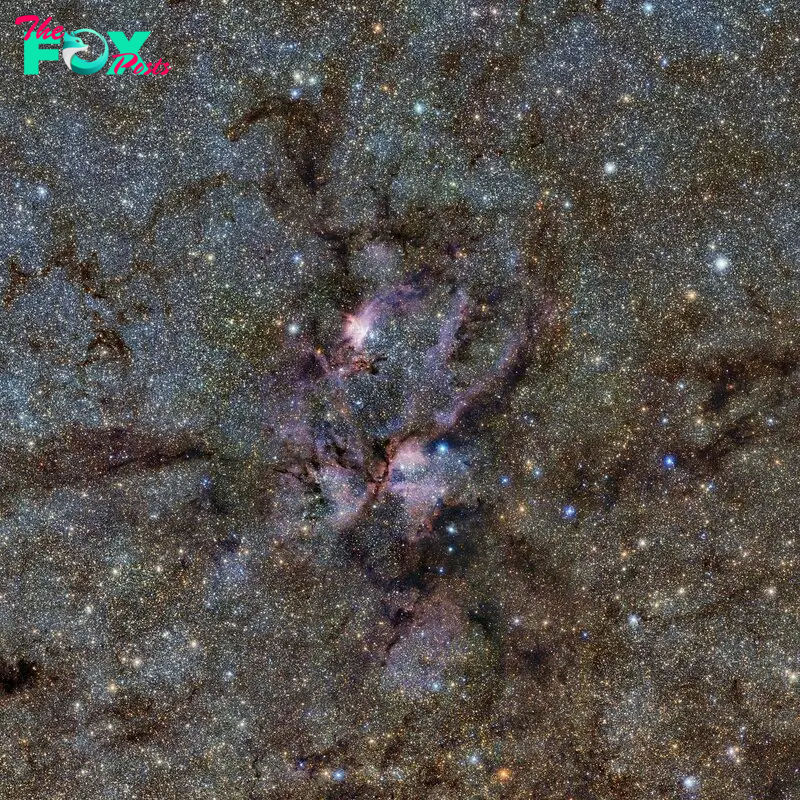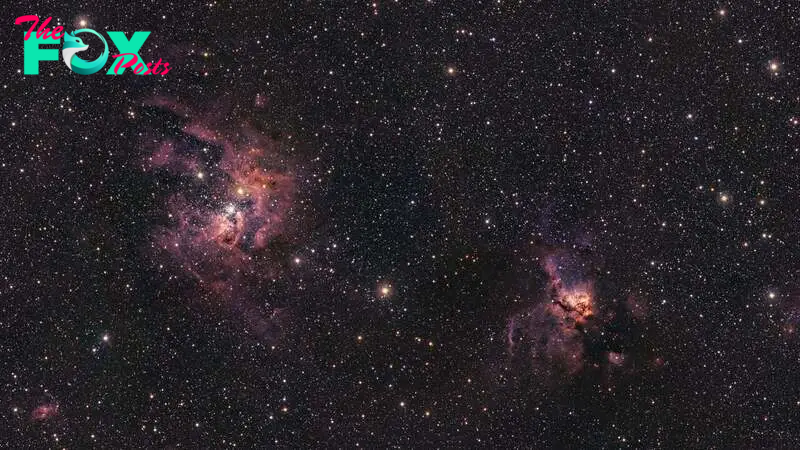Technology
Most detailed infrared map of Milky Way ever released shows 1.5 billion cosmic objects
Astronomers at the European Southern Observatory (ESO) have created the most detailed infrared map of the Milky Way ever made, revealing more than 1.5 billion cosmic objects.
Using the VISTA telescope, located at ESO’s Paranal Observatory in Chile, this unprecedented survey has reshaped our understanding of our galaxy’s structure.
The map, which took 13 years to compile through observations spanning 420 nights, uncovers previously hidden stars, planets, and other celestial phenomena obscured by dust and gas.

An infrared view of the Messier 17 nebula.
The VISTA (Visible and Infrared Survey Telescope for Astronomy) telescope’s infrared camera, known as VIRCAM, was pivotal in penetrating the dense clouds of dust and gas that permeate the Milky Way.
This allowed astronomers to observe objects that emit infrared radiation but were previously invisible to conventional telescopes.
These include "failed stars" — or brown dwarfs, which fall between giant planets and small stars — and free-floating planets that don't orbit any star.

An infrared view of the NGC 6188 nebula and the NGC 6193 cluster.
The map also tracks hypervelocity stars, which have been ejected at incredible speeds from the galaxy’s core after close encounters with its supermassive black hole.
The colossal dataset produced from the survey consists of over 200,000 individual images, covering an area of the sky equivalent to 8,600 full moons.
This dataset is nearly ten times larger than the team’s previous map, released in 2012, and includes not only newborn stars and ancient globular clusters but also stars whose luminosity changes periodically, which are crucial in calculating cosmic distances.

An infrared view of the Messier 22 globular cluster.
Dante Minniti, the project lead and an astrophysicist at Universidad Andrés Bello in Chile, expressed the significance of this achievement, stating, "We made so many discoveries, we have changed the view of our Galaxy forever." His team’s findings were published on September 26th in the Journal Astronomy & Astrophysics.
A Massive Leap in Observational Astronomy
The scope of the VISTA map is staggering, containing 500 terabytes of data, making it the largest observational project ever conducted with an ESO telescope.
The survey spanned from 2010 to early 2023, enabling astronomers to track changes in the brightness and movement of celestial bodies over time.
This long-term monitoring allowed researchers to gather detailed insights into the dynamic processes at work in the Milky Way, particularly in its most hidden regions.

The Lobster Nebula seen with ESO’s VISTA telescope.
The new map includes data from two key projects: the VISTA Variables in the Vía Láctea (VVV) survey and its extended counterpart, the VVVX survey.
Together, these surveys have already generated more than 300 scientific papers, exploring various aspects of galactic formation, structure, and stellar evolution.
The infrared observations made by VIRCAM are crucial for detecting objects that emit faint light, particularly cold celestial bodies like brown dwarfs, which are too dim to be seen in visible light.

VISTA’s view on stellar births.
These "failed stars" never achieved the mass required to sustain nuclear fusion at their cores, yet they glow faintly in infrared wavelengths.
The survey also discovered free-floating planets—rogue objects that do not orbit stars, further expanding our understanding of planetary systems.
Unlocking the Secrets of the Milky Way's Core
By repeatedly observing each region of the sky, the team was able to measure not only the locations of millions of stars but also how they move.
Some of the most fascinating findings include hypervelocity stars — celestial objects flung at incredible speeds from the center of the galaxy.
These stars are believed to have been ejected after close encounters with Sagittarius A*, the Milky Way's supermassive black hole, providing crucial insights into the gravitational forces at play in the galaxy's core.
Additionally, the map provides an accurate 3D view of the inner regions of the Milky Way, previously obscured by dust.
This new perspective has the potential to answer long-standing questions about the structure and formation of the galaxy, including the role of dark matter and the distribution of stars and planetary systems in the galactic disk.
Future Exploration and Technological Upgrades
Although the current survey has been completed, it marks only the beginning of future explorations.
The ESO is now preparing for the next stage of observations, with plans to upgrade the VISTA telescope with a new instrument called 4MOST.
Meanwhile, ESO’s Very Large Telescope (VLT) will be equipped with the MOONS instrument, which will allow astronomers to break down the incoming light from celestial objects into its component spectra.
These advancements will enable researchers to better understand the chemical compositions of the newly discovered objects, offering deeper insights into the origins and evolution of stars and planets within the Milky Way.
Roberto Saito, an astrophysicist at the Universidade Federal de Santa Catarina in Brazil and lead author of the study, noted, "The project was a monumental effort, made possible because a great team surrounded us." The vast amount of data collected will continue to be analyzed for decades to come, leading to further discoveries and advancements in our understanding of the galaxy.
With ESO’s future upgrades, astronomers anticipate countless breakthroughs that could reshape the understanding of the Milky Way and its place in the universe.
-

 Technology3h ago
Technology3h agoPublic health surveillance, from social media to sewage, spots disease outbreaks early to stop them fast
-

 Technology8h ago
Technology8h agoWhy a Technocracy Fails Young People
-

 Technology20h ago
Technology20h agoTransplanting insulin-making cells to treat Type 1 diabetes is challenging − but stem cells offer a potential improvement
-

 Technology1d ago
Technology1d agoShould I worry about mold growing in my home?
-

 Technology1d ago
Technology1d agoBlurry, morphing and surreal – a new AI aesthetic is emerging in film
-

 Technology2d ago
Technology2d agoRethinking screen time: A better understanding of what people do on their devices is key to digital well-being
-

 Technology2d ago
Technology2d agoAn 83-year-old short story by Borges portends a bleak future for the internet
-

 Technology2d ago
Technology2d agoFacebook users in Germany can seek compensation for 2018–2019 data misuse | The Express Tribune



























